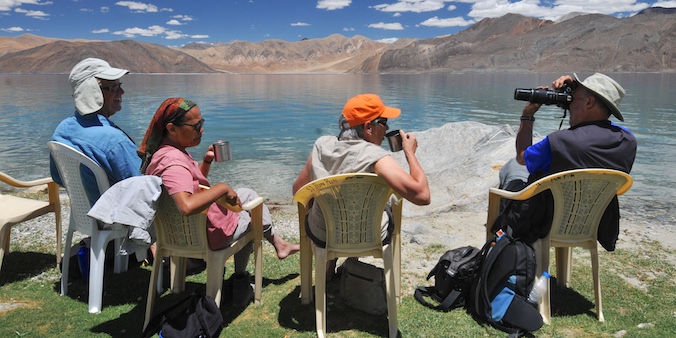LADAKH OVERLAND via SPITI
Tour - 21 days
LADAKH OVERLAND via SPITI
Tour - 21 days
About SPITI & LADAKH
Ladakh is a part of the Indian Himalayas It is located between the Kunlun mountain range in the north and the main Himalayas to the south. Although part of India now, and earlier of the princely state of Kashmir, Ladakh has been an independent kingdom for almost 900 years.
Ladakh is well-known for its starkly beautiful mountain scenery. As a result of its location in the rain shadow of the main Himalayan Range its climate is extremely dry, and due to the high altitude – most valleys are situated at 3300m or higher – winters can be extremely cold. Summers, however, are generally pleasant if not warm and sunny. Ladakh is inhabited by a mix of Indo-Aryan and Tibetan people. Especially the latter, with their colourful buddhist culture, have given the region the nickname of ‘Little Tibet.’
Ladakh in the narrower sense is the Indus Valley with adjacent areas. It is bordered by two mountain ranges: in the northeast by the Ladakh Range, in the southwest by the Zanskar Range. The area around the capital Leh, and further upstream towards Tibet, is referred to as Upper Ladakh. Lower Ladakh is the area further downstream to Kargil, where the Indus enters Pakistan.
The remoter areas of Zanskar, Nubra and Rupshu are now seen as regions of Ladakh. In the past, these areas were sometimes part of Ladakh, sometimes not. They can be visited from Leh by car or on foot. The latter would be your means of transport, if you are up to it. Because, while jeep trips in Ladakh are very rewarding indeed, trekking will give you an even in-depth experience of the land and the people, with the added bonus of a total renovation of body and soul.
Ladakh can be reached by air or overland. This tour takes you by train and car to Ladakh through the regions Kinnaur and Spiti, both in the state of Himachal Pradesh. Kinnaur is the area around the Sutlej, one of the four large rivers that originate on the flanks of holy Mt. Kailash in Tibet. It is an area of steep mountain sides and a culture that interestingly seems to hover in between the two great cultures of India (predominantly Hindu) and Tibet (Buddhist).
Spiti lies wedged in between Ladakh, Tibet and the former small Himalayan kingdoms that lie to the south of the Himalayan Range – such as Gharwal, Kinnaur and Kullu. With Ladakh and Tibet it shares its geographical position north of the Himalayan Range, an area called the Trans-Himalaya. It has a purely Tibetan culture, language and religion (Buddhism). As the Sutlej has found a way to break through the Himalayan Range, following his river upstream is the only access route to the Indian Trans-Himalaya that does not involve crossing one or more high passes. This makes Spiti the most accessible ‘Tibetan’ region in India.
Region
Ladakh
(India)
Best Time
July - Sept.
No. of Days
21 days
Trip Character
Jeep tour
Sleeping Altitude
2350 - 4500 m.
Price
INR XXX/ $ XXX
ABOUT THIS TOUR
On this very varied journey you trek overland to Ladakh via Manali, located at 1800m altitude in the green-forested Kullu Valley. Here you are surrounded by the southern foothilOn this tour you’ll travel along one of the world’s most spectacular road trips, crossing the Great Himalayan Range to Ladakh on the Tibetan Plateau. After a leisurely train ride to Chandigarh, our guide and car will take you to Shimla, the former winter capital of the British India. Here you’ll get a glimpse of the Himalayan giants that await you later in the journey. Then you’ll travel through the deep gorge of the Sutlej, one of the five rivers that originate near the holy Mt. Kailash in Tibet, through Kinnaur.
Gradually you’ll see the landscape changing from lush green and forest-covered to the barren, stark but beautiful high altitude desert of the Trans-Himalaya. At the same time you’ll see a remarkable change in culture and people. “Indians” make way for “Tibetans”, while Hinduism is replaced by Buddhism. In Spiti you’ll see famous Tabo Gompa, probably the oldest lamaist Buddhist monastery in India, and walk among some of the highest villages in the world. The road becomes even more spectacular as you cross three road passes of altitudes between 4885 and 5300 m while traversing an immense no-man’s land between Spiti and Ladakh. Reaching the Indus Valley and Ladakh’s capital Leh, will be like reaching Timbuktu.
After reaching Leh there are many options for exploring Ladakh further before flyng back to Delhi, ranging from 3 days to 3 weeks. We suggest either doing a trek or doing the circle trip Leh – Shyok – Pangong Lake – Nubra Leh.
After reaching Leh you may not want to take the first flight out to Delhi as there is so much to discover within Ladakh itself. We recommend staying at least 8 days, two days to see Leh and its surroundings and 6 days to explore Nubra Valley and Pangong Tso – See here. You can also embark on a trek or continue by road to Kargil and on to Kashmir – See here.
YOUR custom-made TRIP
The tour described here, as well as the other ones on our website, are mainly meant as suggestions. We would be happy to offer you a travel proposal that fully meets your personal demands and expectations. That means that you choose where you want to go, what level of accommodation and type of transport you want and what activities you prefer.
Please let yourself be inspired by this and other trips on our website and then drop us a line (or call us up) to explain your travel wishes. We will be happy to help you put together the perfect trip. You can send us an e-mail or call us over Whatsapp.
EXTENSIONS & VARIATIONS
Apart from the tour as described here, you could consider the following add-ons and changes:
- After reaching Leh do a 6-day exploration jeep tour to Nubra Valley, Shyok and Pangong Tso.
- Do a trek in the Indus Valley near Leh. For instance the easy but rewarding 4-day Sham Trek See here. You sleep in homestays where you get to meet the Ladakhis up-close. Or the more demanding 5-day trek from Chilling to Lamayuru. On this trek you sleep in trekkers tents while a walk-along cook prepares your meals. You walk longer distances, climb higher passes but the rewards are even better views, more authentic villages. See here.
- Spend a day rafting on the Indus. There are different grades available, so there is the easy but fun to do level as well. Professional oarsmen will be with you in any case. You will be picked up from your hotel and dropped off there again at the end of the day, a pic-nic lunch is included.
- Continue the trip after visiting the Indus Valley and Nubra in the direction of Kargil. Then, cross the Himalayan Range again, southward to Srinagar (Kashmir). Here, you can end your tour relaxing a couple of days on a houseboat on idyllic Dal Lake. This is our tour Ladakh full circle.
ITINERARY
-
Day 1: New Delhi - Chandigarh - Shimla (4 h train, 3 -4 h car)
Your journey starts with a 4-hour train ride from Delhi to Chandigarh. Here, our driver is waiting to take you up into Shimla, situated at 2275m in the Himalyan foothills. Altitude 215 → 2200m. -
Day 2: In Shimla
Today you'll do some relaxed sightseeing, including a visit to the splendid Viceregal Lodge, a castle-like gothic structure, and the nearby Himachal State Museum, a colonial building with some interesting collections of miniatures, stone sculptures, handicrafts, etc. Altitude 2200m. -
Day 3: Shimla - Sarahan (7 - 8 h)
Today we enter Kinnaur, a region with magnificent mountain scenery and interesting local architecture. The route through the Sutlej Valley with its many apple orchards takes us through several small towns, like Nirth, with an old Sun God temple. Altitude 2200 → 2680m. -
Day 4: Sarahan - Sangla (4 - 5 h)
Going to Sangla (2680 m) takes about 4 to 5 h on a well-surfaced road. The small town, with a temple and a nearby fort, has a majestic setting in a deeply carved valley surrounded by snowy summits. Altitude 2680 → 3450m. -
Day 5: Sangla - Chitkul - Sangla
This daytrip starts with a steep climb along a narrow road to beautiful Chitkul (3450 m) with a 500 years old temple. Another village to be visited is Rackcham, which has a striking location, surrounded as it is by granite cliffs and forests. Altitude 3450m. -
Day 6: Sangla - Rarang (6 h)
After a descent to the Sutlej river we continue upstream until we reach the beautiful village of Rarang. On the way we pass many orchards and vineyards and visit Ribba, famous for its ‘angoori’ (grape wine). Additionally Kanum can be visited, a monastic village with seven temples. Altitude 3450 → 2650m. -
Day 7: Rarang - Tabo (6 h)
Today we ‘cross’ the Himalayas through a deep gap cut by the Sutlej river and reach Khab, where the Spiti river joins the Sutlej. From here – high above the dramatic Spiti gorge - the roads zigzags 1200 m up to Nako (3660 m), and continues to Tabo (3280 m). Nearby Tabo Gompa counts as one of the most important temples in the Tibetan cultural area. A gompa is a Buddhist monastery and/or temple. Altitude 2650 → 3050m. -
Day 8: Tabo - Shego/ Kaza (5 h)
Driving along the Spiti Valley we pass many villages and monasteries. Before reaching the capital Kaza we make a side trip to Pin Valley National Park, famous for its wild life which includes ibex and the shy snow leopard. Time permitting, we also visit spectacularly located Dankar (3900 m), former capital of an old Spiti kingdom. Overnight at Shego near Kaza. Altitude 3050 → 3600m. -
Day 9: Visit high villages
By jeep we visit several interesting high villages with striking locations. Doing a short trek is possible too. See two highlights. Very picturesque is Ki Gompa, which belongs to the Yellow Hat Sect and is one of the biggest and the oldest monasteries in Spiti. Altitude 3600 → 4300 → 3600m. -
Day 10: Shego - Chandratal (5 - 6 h)
We cross the Himalayan Range (again) as we drive over Kunzum pass (4550 m). Soon we take a narrow track to Chandratal (4270 m). The first sight of this wondrous ‘Moon Lake’ takes one’s breath away. Massive mountaintops and glaciers dominate the lake with shores carpeted with alpine flowers. Camp next to the lake. Altitude 4250m. -
Day 11: Chandratal - Serchu (6 - 7 h)
We are in the Lahaul-region now and join the Manali - Leh Highway. The next two days you will drive over high passes, winding roads and hairpin bends, sometimes crossing landslides and small rivers. This is one of the most spectacular mountain roads in the world! First we pass many Lahauli villages surrounded by fields of potato and peas with snowcapped mountains all around. Then a long climb leads to the Baralacha La (4890 m). Here you cross the Himalayan chain (again) and enter the immense no man's land of the Trans-Himalaya with beautifully coloured mountains. Beyond are the Lingti Plains, where you overnight in a tented accommodation. Altitude 4200 → 4890 → 4200m. -
Day 12: Serchu - Leh (8 - 9 h)
The road climbs to the next two passes, including the Lachalung La (5060m) and soon you may see nomads wandering around with goats and yaks. After crossing the very high Taglang La – 5300 m - you reach the actual Ladakh. You pass the first Ladakhi houses, white painted and made of stamped clay. Yaks, prayer flags, stupas and green barley fields complete the Tibetan atmosphere. Soon the legendary Indus river is reached. Overnight in Leh in a comfortable guesthouse. Altitude 4200 → 5300 → 3600m. -
Day 13 & 14: In Leh
Leh is a pleasant little city with many restaurants and shops, and opportunities for short walks. Highly recommended are excursions by taxi to some of the many nearby Buddhist monasteries. Altitude 3600m. -
Day 15 -20: Suggested: Jeep tour Nubra Valley
After reaching Ladakh, you obviously would want to explore this. Fascinating place. We suggest, as a minimum, do do a 6-day tour of Nubra and Pangong Lake. See here. -
Day 21: Flight Leh - Delhi
Early morning transfer to the airport. On a clear day the flight offers breathtaking views of the colorful mountains of Zanskar and the glacier-capped peaks of the Great Himalayan Range.
HIGHLIGHTS OF THIS TOUR
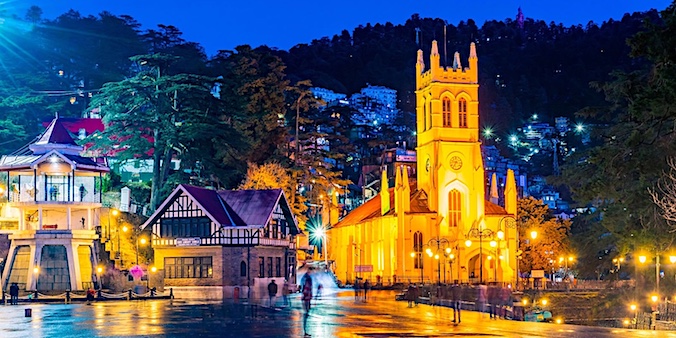
SHIMLA
SUTLEJ GORGE (KINNAUR)
The Sutlej (or Satluj) River is one of the five rivers that originate near the sacred Mount Kailash in Tibet. The 1450 km long river enters India near the 3930 m high Shipki La in the state of Himachal Pradesh. Near this entry point the powerful river managed to cut a dramatically deep gorge right through the Himalayas. From there on it wrestled its way through beautiful Kinnaur. Today, after a long journey it reaches the flats of Indian Punjab, enters Pakistan, empties itself into the mighty Indus river and finally reaches the Arabian Sea. In the remote valleys of Kinnaur local principalities and cultures came into existence, made possible by fertile soils, good climate, and strategic locations for defence and trade.
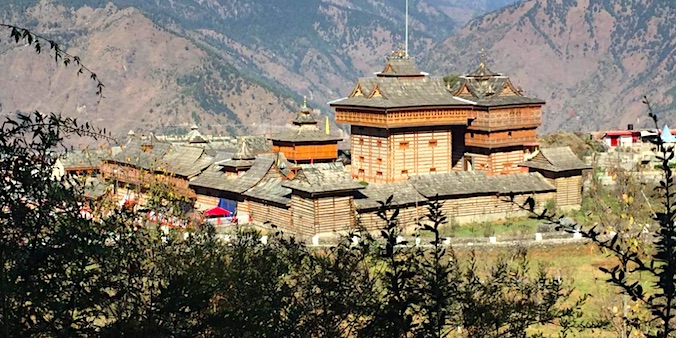
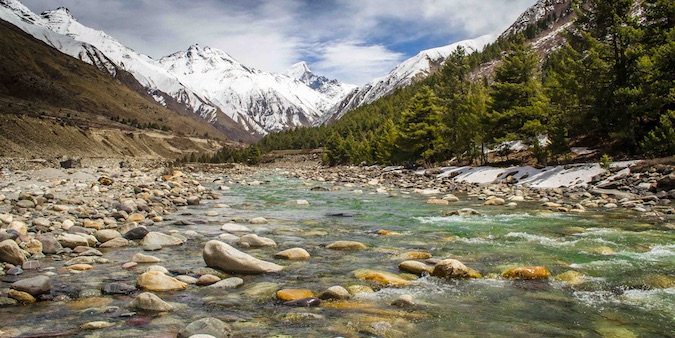
SANGLA VALLEY
Tabo Gompa
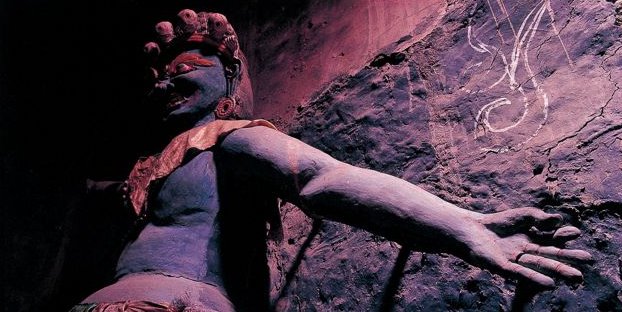
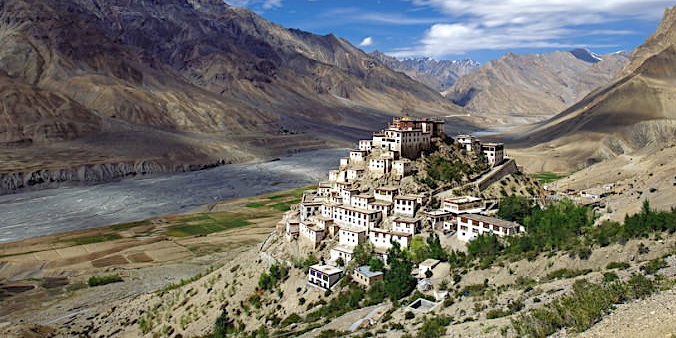
Spiti Valley
This 150 km long valley is located northeast and in the rain shadow of the Great Himalayan Range. This has resulted in a dry mountainous moonscape of stark beauty interspersed with oasis-like villages. In many places fortress-like gompas, situated on a hilltop or a protruding section of a mountain, dominate the valley. Until not so long ago – before the road from Shimla was constructed – Spiti was difficult to reach from India proper, but it was well connected through trade routes with neighbouring Buddhist Tibet and Ladakh, with which it has always maintained strong cultural and religious ties with Tibet. The dialect spoken in Spiti is very similar to that of Southeast Tibet.
High Villages of Spiti

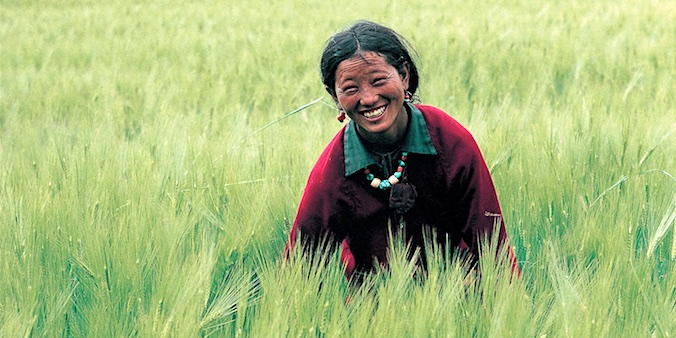
trek along high villages
Trekking here is not particularly strenuous, assuming you are well acclimatized to the altitude. Walking: approx. 3,5 – 5 h per day. Per day up: 250-300 m; down: 300-700 m. A 2 – 3 day trek could start in Komik (4500 m) with its fortress-like gompa, walk to a low pass (4775 m) and descend to ‘medieval’ Demul (4400 m). Next day after a long descent you reach Lalung (3660 m) with its ancient ‘Golden Temple’. On day 3 pick up by jeep or continue to spectacularly located Dhankar (3880 m). All along there are beautiful views of the Spiti Valley and Himalayas. Overnight in simple guesthouses. Luggage: by horse. Longer options are possible.
HIMALAYA CROSSING
Between Spiti and Ladakh you will cross the Himalayan Range twice. This awkward fact is due to a bend in the Himalayan Range. Leaving the high valley of Spiti behind, you first climb to the Kunzum La (xxxm). Then you descend to the town of Keylong (3000m) in Lahaul. The next day you again climb up to a Himalayan pass, this time the Baralacha La (4900m). Ony after crossing this pass you’ll enter the high altitude plain of Changtang in eastern Ladakh. Because the area is to high for agriculture, there is hardly any inhabitation. You may see nomads wandering around with their goats and yaks. The goats produce the extremely warm pashmina wool, out of which the famous cashmere woollens are woven.

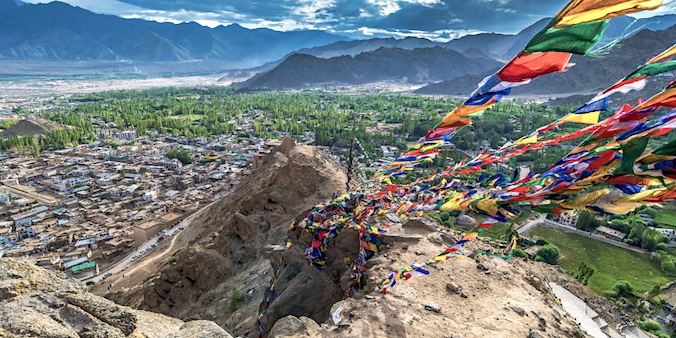
LEH
CARAVAN ROADS OF LADAKH
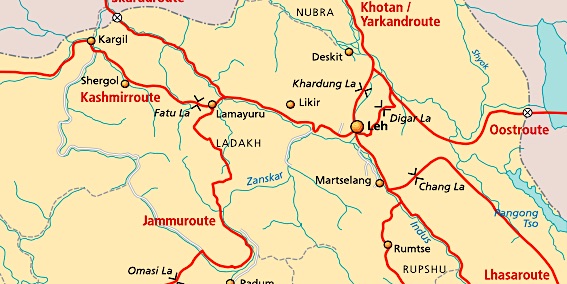
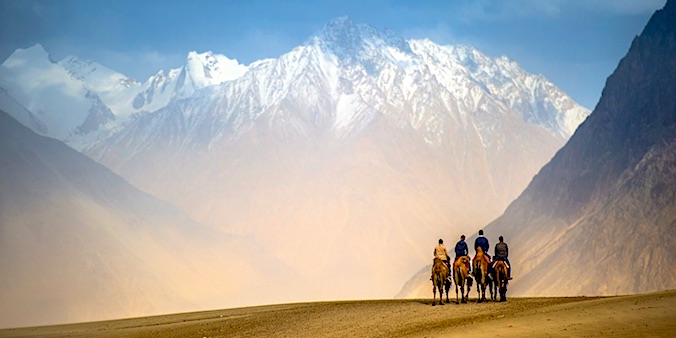
NUBRA VALLEY
SHYOK RIVER LODGE

